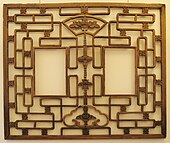Chinese wooden lattice
In doors and windows processed wood lattice are one of the traditional Chinese architecture is considered a defining element, which in China is a special handicraft and aesthetic attention.
Cultural background
Until recently, Chinese architecture was determined to a much greater extent than in “western” architecture by the use of wood as a building material and the design of doors and windows. The end of this era coincides with the end of the Qing rule ( Xinhai Revolution ). Over millennia, a tradition based on craftsmanship and deeply rooted in the culture and religion of China had been developed and continued, which placed its practical and aesthetic emphasis on the manufacture of doors and windows. These were not only used for entering and ventilating a house, but the windows were the building's supporting elements and - like the whole building - also made of wood. The doors and windows in their craftsmanship and artistic design also represented the hierarchical demands of the landlord. At first only the emperor and his court could afford this; Only with progressive craftsmanship on the one hand and increasing prosperity of broader sections of the population on the other hand was the installation of richly decorated doors and windows no longer limited to palace construction (example: Forbidden City ), but also included the construction of ordinary houses on a broad scale . This development reached its peak in the Ming and Qing dynasties.
The most widespread regional witnesses of this craftsmanship are in southern China, for example south of the Yangtze River. Because of the different, harsher climatic conditions, the construction features in northern China are different from those in the south; For example, closed wooden doors are preferred, not openwork.
Chinese windows were not glazed; the openings were closed with paper where necessary - depending on the climatic conditions . The paper used was again, depending on the homeowner's financial situation, from simple to high quality, and often also painted.
Construction and craft techniques
A Chinese wooden door or a Chinese wooden window consists of differently designed parts, from top to bottom usually first of a band-shaped wooden plate (chin .: yaoban ), below the actual elongated grid (chin .: geyan ), underneath again a plate, often followed by an "apron" (chin .: qunban ), also made of wood, and finally a wooden plate at the bottom. Wooden components that could be opened were also called " partition door " (chin .: geshan , engl .: partition door ). The Chinese designations of the construction details have changed over the course of time - from dynasty to dynasty - which also takes into account the stylistic changes and changing weightings.
There are several techniques of processing such wooden elements:
- Connecting straight wooden parts and assembling them to form arches using a groove and tenon , each at the ends of the wooden parts;
- Connecting and inserting the wooden parts, not only over their ends, but also elsewhere;
- Joining only straight strips of wood (rather rare technique, as it is also monotonous);
- Carving out of the whole wooden panel, the most diverse technique for artistic design.
When carving for doors and windows, there are other distinctions:
- Relief carving (mostly common);
- Open-work carving: the subsurface is completely removed, the actual carving pattern is retained, viewed either on one side or on both sides;
- Inlaid carving: Possibility of different colors thanks to inlaid wooden plates of different colors;
- Gluing technique: the different colored wooden panels are glued on;
- Line carving: carving a pattern into the wood
Patterns and motifs
Geometric and floral patterns of various kinds can be found. Landscapes take up a broad design framework, as is generally the case in Chinese painting . Historical personalities (such as Lao Tzu or Confucius ) and above all the so-called Eight Immortals from Daoism were depicted on the wooden doors and windows as in other objects. Or the four favorite activities of fishing, wood cutting, plowing and reading, which in ancient China stood for a healthy lifestyle.
Often the representations carved in wood refer to episodes from fairy tales and stories as they were known from plays. The cultural life of the Chinese over the centuries can be read from the abundance of carved images on the doors and windows of their houses. In this context belongs the very popular rendering of “ancient” motifs in the sense of the Chinese tradition such as lotus blossom, bamboo , jade , ivory , enamel and other objects. The Seven Treasures, Eight Treasures or Nine Special Decorative Patterns and other typical cultural references, as they were alive in the people, are used as motifs on the Chinese doors and windows.
Instead of the floral or figurative representations, there are also characters in the middle of the Chinese wooden lattice, primarily aimed at good wishes for health and a long life.
Image source
The objects shown come from the collection of Professor Dr. Johannes Greten, Heidelberg. Origin: region around Chengdu .
literature
The book by Ma Weidu Classical Chinese Doors and Windows , China Architecture & Building Press, Beijing, 2001, provides a profound insight into the subject . ISBN 7-112-04279-8 , newer edition: 2006/2011 ISBN 978-7-112- 08745-7





